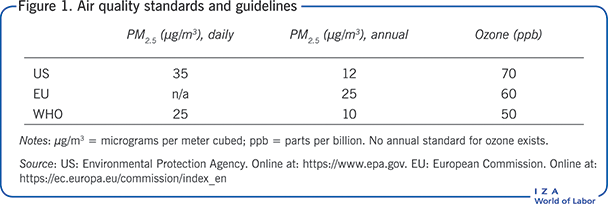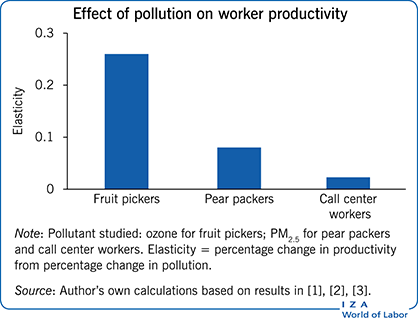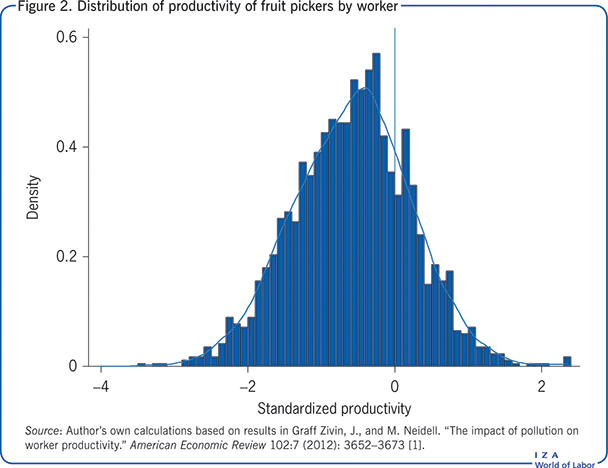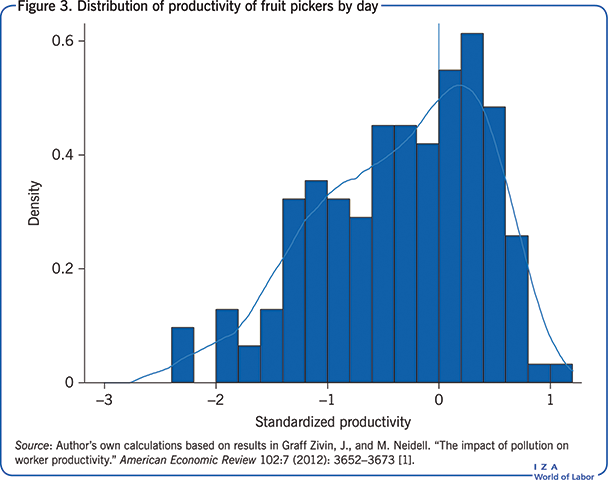Elevator pitch
Environmental regulations are typically considered to be a drag on the economy. However, improved environmental quality may actually enhance productivity by creating a healthier workforce. Evidence suggests that improvements in air quality lead to improvements in worker productivity across a range of sectors, including agriculture, manufacturing, and the service sectors. These effects also arise at levels of air quality that are below pollution thresholds in countries with the highest levels of environmental regulation. The findings suggest a new approach for understanding the consequences of environmental regulations.
Key findings
Pros
Improvements in air quality have led to significant increases in worker productivity.
Poor air quality does not affect a worker’s decision to work or the number of hours worked, at least on a daily basis, for the levels of pollution found in nations with the highest levels of environmental regulation.
Air quality standards that lower pollution levels would likely lead to improvements in worker productivity.
Cons
Poor environmental quality reduces worker wages in settings where pay is based on performance.
Worker productivity captures more subtle effects of pollution, which are likely to be widespread.
Reduced worker productivity occurs at levels of pollution well within current air quality standards and guidelines.
Author's main message
Evidence suggests that pollution can reduce the productivity of individual workers. At the same time, environmental regulations are often considered to be a drag on the economy, as they can slow down production and lead to business closures and job losses, with resulting higher costs for consumers. Yet effective environmental regulations improve the air one breathes and the water one drinks, so those who keep their jobs are more likely to be healthier and more productive as a result. The extent to which these gains in worker productivity offset or even overcome the perceived negative effects of regulation is therefore an essential consideration for designing optimal environmental policy.
Motivation
Poor air quality has been linked with many negative health effects, particularly for more susceptible populations in society such as infants, the elderly, individuals with pre-existing health conditions, etc., and for more severe outcomes, such as mortality and hospitalizations. A growing body of evidence indicates that pollution also has more subtle effects on workers by reducing how much is produced “on the job.” Such productivity losses occur at pollution levels that comply with air quality standards and guidelines.
Focusing on worker productivity as an outcome is important, for at least three reasons. First, most prior evidence that has looked at the effects of pollution has focused on health outcomes, and typically rather extreme events, such as mortality and hospitalizations [4], [5]. As such, this approach misses the more subtle effects of pollution that do not lead to such dramatic changes in health, but may nonetheless affect people on a daily basis. If productivity is thought of as a summary measure of the wide range of daily influences that a worker experiences, then it would necessarily have to capture these more subtle daily influences, as well as the more direct and obvious ones, such as asthma attacks.
The second reason for why productivity is an important outcome is that these more subtle effects of pollution on society may be very widespread. Many of the studies that focus on the extreme outcomes mentioned above typically focus on more sensitive populations, such as infants, the elderly, and those with underlying health conditions, rather than on the whole working-age population. They therefore miss a large fraction of the total population. By definition, productivity focuses on the working-age population, and by doing so identifies effects of pollution that may be more widespread than was previously believed.
Third, productivity is an outcome that is easily monetized, which therefore makes it relatively straightforward to calculate its cost to society and to include it in cost–benefit analyses of air quality policies. Quantifying the full range of effects that pollution causes is essential for the setting of optimal environmental policy. Whereas measuring the benefits from various health outcomes involves controversial assumptions, such as monetizing the discomfort caused by illness, productivity effects can be quantified directly as the loss in worker earnings.
This article reviews the small, but growing, literature that relates air pollution to worker productivity. There are significant empirical challenges involved in this field of study, namely the paucity of high-quality data on worker productivity and concerns about the non-random assignment of pollution exposure. Given these concerns, only a handful of reliable studies are available, all of which tend to focus on narrow contexts where such data exist. Nonetheless, taken together, the results tell a consistent story: increases in air pollution reduce worker productivity, even at levels of pollution generally considered to be safe. This finding holds across a range of different contexts, from agricultural and manufacturing workers in California to the service sector in China.
Discussion of pros and cons
Why might there be a link from pollution to worker productivity?
Research has linked worker productivity with two pollutants: (i) ozone; and (ii) fine particulate matter (PM2.5). Ozone is a gas that is not directly emitted but forms from complex interactions between nitrogen oxides and volatile organic chemicals, both of which are directly emitted, in the presence of heat and sunlight. PM2.5 consists of solid and liquid particles in the air that vary considerably in size. PM2.5 derives from natural sources, such as volcanoes and wildfires, and man-made sources resulting from fossil-fuel combustion.
While both pollutants have well-established effects on various health outcomes, what is more relevant for the context under study are the more subtle effects that may affect productivity. Ozone can lead to minor “insults,” or influences, that may not necessitate the use of formal health care, such as decreases in measures of lung performance. PM2.5 has been shown to affect blood pressure; cause irritation in the ear, nose, throat, and lungs; and induce mild headaches. PM2.5 has also been linked with cognitive effects, such as reductions in test scores. These symptoms from exposure to pollutants can arise as quickly as one hour following exposure, with effects being exacerbated by exercise and continued duration of exposure. (Long-term effects may also result from exposure to these pollutants, but estimating the effects from long-term exposure on productivity has not been the focus of ongoing research; the non-random assignment of pollution exposure is even more complex over longer periods of time.) Figure 1 shows existing government air quality standards for the US and EU, and recommended guidelines defined by the World Health Organization (WHO) for these two pollutants.

An important difference between the two pollutants is their ability to penetrate indoor settings. Ozone rapidly breaks down and disappears once it enters indoors. Consequently, outdoor and indoor ozone levels show very little correlation. PM2.5, however, can easily enter buildings, with indoor levels ranging anywhere from 70–100% of outdoor levels [6]. This suggests that ozone may only affect workers in outdoor settings, while PM2.5 can affect workers both outdoors and indoors.
How these subtle changes affect productivity is not well understood. For physically demanding tasks that involve repetitive motions, or standing and/or bending, a plausible link is through increased fatigue and decreased stamina. For tasks without physical demands, the channel may arise through the need for work breaks to care for oneself, as well as a cognitive channel whereby task performance is compromised.
Figure 2 and Figure 3 plot the distribution of the productivity of fruit pickers at a farm in California, hinting at the possible role of environmental factors in affecting worker productivity. Figure 2 plots the average productivity across all workers on the farm by taking the average output of each worker across all days worked at the farm. Not surprisingly, some workers produce considerably more than other workers on a consistent basis. Figure 3 plots the average productivity across days by taking the average of all workers’ output on each given day. The variation in productivity across days is nearly as large as that across workers, which suggests a potentially important role for day-to-day factors, such as pollution, in determining productivity.
Empirical challenges and solutions
There are two major empirical challenges researchers must overcome in order to estimate the effect of pollution on worker productivity (see [7] for a more thorough description). The first centers on the availability of high-quality measures of worker productivity. General measures of labor productivity used as leading indicators of economic growth are widely available. These measures, which essentially divide the total output of a nation by the number of workers, are far from ideal because they do not isolate worker productivity from other inputs, such as physical capital and technology.
The second challenge is the endogeneity of pollution. A large share of pollution is caused by business activity. As firms increase their production (where reliance on workers is a major means of achieving this), they emit more pollutants into the environment. This leads to “reverse causality,” where higher levels of productivity lead to higher levels of pollution. Another concern is that individuals may choose where to live (and work) in part based on the level of air quality in that location. When this is the case, it leads to a non-random assignment of pollution, which may give rise to a spurious relationship between pollution and productivity. For example, higher-paid individuals may choose to live in cleaner areas. These higher-paid individuals may have higher levels of human capital or other unobserved factors that affect their productivity, and these are now correlated with their pollution exposure because of their decision regarding where to live.
The main approach for overcoming these issues has been through the use of detailed data on worker productivity from specific firms where individual-level productivity is tracked. This typically arises in situations where performance-based pay is the norm, e.g. piece-rate wages. These data often come from administrative records that the business uses to pay its workers. Although these measures do not capture all aspects of productivity in all contexts, they are generally a high-quality and reliable measure of worker productivity at the individual level.
With these daily measures of worker productivity, existing studies explore the relationship between pollution and productivity using high-frequency variation in these variables. For example, daily measures of pollution are correlated with daily measures of productivity, adjusting for other daily-level factors that may affect productivity, such as the weather. This approach addresses the endogeneity concerns because the emissions of the firm being studied are often trivial, or even non-existent, compared to the plethora of industrial activity that affects air quality in the vicinity of the firm. Furthermore, many of the economic factors affecting air quality are unlikely to change on a daily basis. Workers are also followed over time, for as long as they stay with the firm, so any relocation decisions are addressed, which further limits the concerns that stem from endogeneity of pollution exposure.
This approach is not without shortcomings, of which two stand out. First, given the goal of estimating the effect of pollution on worker productivity, it is important to ensure that the estimates are not influenced by changes in labor supply. If pollution affects how many hours someone works, or whether or not someone works at all, then any estimated effects of pollution on productivity could suffer from what is known as “sample selection bias.” That is, on a high-pollution day, productivity may be observed for a different sample of workers than on a low-pollution day, and these different samples may have different underlying rates of productivity. If this bias exists, there is no readily available solution to correct it. Instead, its existence must be tested for by assessing whether pollution relates to labor supply. Given that the uniquely collected data sets contain data on labor supply, this can be directly assessed using measures of the probability of working and the number of hours worked. If these outcomes are uncorrelated with pollution, then sample selection bias is not an issue.
It is also worth noting that, although it introduces a bias for understanding the effects of pollution on productivity, a finding that pollution affects labor supply is an important outcome in its own right. If someone misses work because of a high pollution day, the loss in productivity from that worker is a clear loss to the economy. For example, evidence shows that the closing of a large oil refinery in Mexico City led to a significant increase in the amount of time spent at work for people in surrounding neighborhoods [8]. This is a clear economic benefit from reduced pollution. An important distinction between labor supply and productivity is that changes in labor supply reflect a more noticeable effect for the employee and employer, which is akin to understanding the more extreme effects from pollution exposure, as has been previously discussed.
Changes in worker productivity, on the other hand, reflect a more subtle effect that may go unnoticed by the employer or even the employee. This distinction between absenteeism and presenteesim can be quite important, as some studies estimate the costs of presenteeism to be larger than absenteeism. For more evidence on the effects of pollution on labor supply, see [8], [9], [10].
The second concern from using daily variation as a means of understanding the relationship between pollution and worker productivity, hinges on potential “confounding” from other environmental sources. The changes in pollution from one day to the next can be driven by economic-related events and natural events. Although economic events, such as traffic delays, can be a source of bias in many settings, they do not present an issue because they are not likely to be related to the activities of the specific firm being studied. As such, the variation in pollution caused by such events is precisely the kind of variation that is useful for understanding the effect that is of interest. Changes in natural events, such as weather patterns, however, may present an issue because they may affect productivity as well; for example, a hot, humid day may also directly affect worker fatigue. Since weather data are widely available, the main approach for addressing this problem is to assess the sensitivity of results to flexibly including numerous weather measures, such as temperature, humidity, precipitation, and wind.
Existing evidence
Agricultural sector
The first piece of evidence on this topic examined the effect of ozone on the productivity of agricultural workers at a farm in the Central Valley of California in the US [8]. In this outdoor setting, workers were paid via piece-rate for each unit of fruit they picked, thus providing a clean measure of daily productivity. Using pollution and meteorological data from a nearby monitor, the authors performed regressions that linked daily changes in ozone with daily changes in productivity, while controlling for local meteorological conditions and seasonal trends, given the nature of agricultural work.
The authors found that increases in ozone led to significant decreases in productivity. Workers picked less fruit on days when ozone was higher. Ozone, however, did not affect the labor supply of workers, suggesting sample selection bias was not present. Importantly, the study found that even at relatively low levels of ozone—around 40 ppb (parts per billion), which is well within current air quality standards—there was still an effect on worker productivity. Approximate calculations that apply their estimated effect to the whole of the US suggest that a policy-relevant 10 ppb reduction in the ozone standard would translate into an annual cost saving of approximately $700 million in labor expenditure in the agricultural sector.
Manufacturing sector
While agriculture is a large fraction of economic output in many nations around the world, it accounts for a small fraction of national income among nations with the strongest institutional capacity for regulating the environment. The manufacturing sector, on the other hand, represents a much larger share of economic output in such nations. Related evidence links PM2.5 with worker productivity in the manufacturing sector [2].
In this study, the authors focus on workers at a pear-packing factory in the US. The workers place pears into boxes that are shipped around the county, and receive piece-rate compensation for each box they produce. An important distinction from the agricultural setting is this activity occurs in an indoor environment. Exposure at various times throughout the day may affect workers, including exposure during the work-shift, given the ability of PM2.5 to penetrate indoors.
Linking productivity with pollution and meteorological data, the authors found that increases in PM2.5 significantly reduces the number of boxes the workers pack. As with the previous study, the authors also found that PM2.5 does not affect labor supply. PM2.5 also had effects on productivity at levels below air quality standards, with effects arising at 20–25 μg/m³. In terms of the magnitude of the effect, based on approximate calculations, the authors estimate that the worker productivity effects represent roughly 25% of the total benefits (as measured by changes in housing values) from improvements in air quality.
Service sector
The above two pieces of evidence focus largely on low-skilled tasks, thus omitting a large fraction of modern economies. In recent work, researchers explore the effect of PM2.5 on the output of call center workers, which represents an important part of the service sector, in two cities in China [3]. In this setting, worker output is routinely monitored, as the workers receive partly performance-based pay depending on the number of phone calls completed, thus providing precise measures of each worker’s daily output. As with the manufacturing study, workers were in an indoor environment.
After linking the worker-level data with nearby pollution and meteorological data, the authors found that increases in pollution lead to significant decreases in worker productivity. On high-pollution days, workers reduced the number of calls they placed or received, with this being largely driven by an increase in the number of breaks taken throughout the day. As with the previous studies, no effects were found for labor supply, suggesting sample selection bias is unlikely to be present.
Unlike the previous two studies, however, the effect only arose when air quality levels exceeded the current air quality standards. This difference could reflect many different factors, such as the different nature of the work and/or the poorer quality measures of pollution. In extrapolating the results to another setting to provide a gauge of the magnitude of the effect, the authors calculate that bringing the city of Los Angeles into compliance with air quality standards would increase service sector productivity by $374 million.
Additional evidence
In addition to the above studies, there is further evidence that links air pollution with worker productivity in other contexts. PM2.5 has been found to lower the output of manufacturing workers in the Hebei province of northern China [11]. The authors obtained detailed productivity data from two firms and performed a similar analysis to the previously mentioned studies, and found productivity effects from exposure over a 30-day period.
Furthermore, PM10, which consists of fine particulate matter as well as coarse particulate matter, has been linked with the performance of professional football players throughout Germany [12]. After assigning air quality data to the nearest stadium, the authors found that the number of passes per match decreased on days with higher levels of PM10. While this is a useful measure of one aspect of productivity for football, a limitation is that it is difficult to translate this outcome into economic costs, unlike the case for the previously discussed studies. More importantly, these studies further extend the relevance of the pollution–productivity link to a broader population.
Limitations and gaps
All of the existing studies have focused on isolated contexts, dictated by data availability and ability to isolate causal effects. However, two important gaps are: (i) evidence for the highest-skilled sector, where the value added to the economy is potentially the highest; and (ii) evidence from a wide variety of employment settings (that still recognizes the need to maintain the empirical standards of previous work).
Although the productivity loss is a direct measure of welfare effects, it may not fully capture the harm experienced by workers. The loss in potential earnings to the workers, if in a setting with performance-based pay, does not capture any pain and discomfort they experience. Furthermore, all effects reflect short-term relationships. Given that the long-term effects of pollution on health are generally believed to be larger than the short-term effects, the same may be true for productivity. This represents a fruitful area for future research.
Summary and policy advice
Consistent evidence now exists across multiple settings that air pollution harms worker productivity. These effects arise in both indoor and outdoor environments and at varying levels of worker skill. They also arise at levels of air pollution generally considered to be within existing air quality standards and guidelines. Although the damage per individual is small when compared to more extreme events, such as mortality and hospitalizations, the effects are more widespread and may thus represent an important cost to society.
There are two related implications from this research. First, in countries with well-enforced air quality policies, an effect on worker productivity is, as a result, a much-overlooked benefit, suggesting a strengthening of air quality policy would lead to greater benefits than previously believed. Second, in countries with more limited air quality policies or ineffective environmental regulations, where the environment is often sacrificed in the name of economic growth, this evidence suggests that such an approach may be misinformed because it overlooks the potential gains to the economy from the improvement in worker productivity. A complete understanding of the full extent of the productivity effects is thus essential for informing these decisions.
Acknowledgments
The author thanks two anonymous referees and the IZA World of Labor editors for many helpful suggestions on earlier drafts. Previous work of the author contains a larger number of background references for the material presented here and has been used intensively in all major parts of this article [1], [2], [3].
Competing interests
The IZA World of Labor project is committed to the IZA Guiding Principles of Research Integrity. The author declares to have observed these principles.
© Matthew Neidell


